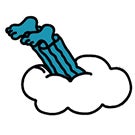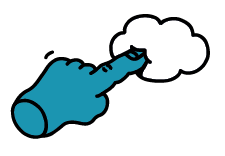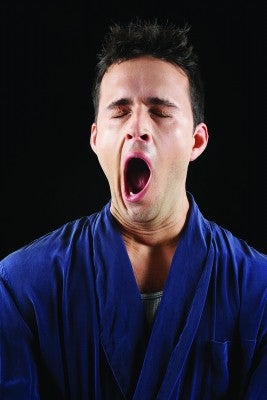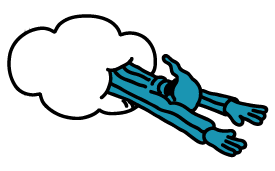The Science of Sleep
From neuroscientists to engineers, USC researchers delve into what happens during slumber—and how to help us get more of it.
In the classic fairy tale, Snow White bites into an apple and slips into a state of suspended animation. For her fellow figment of fiction, man-about-the-Catskills character Rip Van Winkle, a sip of moonshine affords the luxury of sleeping through the American Revolutionary War. Sleep has long featured in our collective storybook as an enigmatic netherworld, a far away place where strange things happen and then are forgotten upon our return to reality.
Turns out there’s a reason for the mythology. Left to investigate why humans spend nearly a third of our lives in slumber—and what sleep is—scientists don’t have a simple answer.
Why we sleep is still one of the greatest unsolved mysteries of science.
Terese Hammond
“Why we sleep is still one of the greatest unsolved mysteries of science,” says Terese Hammond, Keck Medicine of USC pulmonary critical care physician and director of the USC Sleep Disorders Center. “No one yet knows the true purpose and nature of the state of sleep.”
 We may not know the reasons behind it, but here’s what’s clear: Many of us don’t get enough of it.
We may not know the reasons behind it, but here’s what’s clear: Many of us don’t get enough of it.
More than a third of Americans get less than the needed seven hours of snoozing a day, according to the U.S. Centers for Disease Control and Prevention. Over time, lack of sleep takes a toll on our well-being—so much so that the CDC calls it a public health epidemic. That makes the field a formidable frontier for scientists and physicians.
“This is a very exciting time for sleep research,” says Steve Kay, dean of the USC Dornsife College of Letters, Arts and Sciences and a biologist who has long studied the sleep-wake cycle. It’s also a growing area for USC physicians and other health care professionals who see the wider effects of poor sleep among the patients in their clinics and exam rooms.
Understanding Sleep
What happens to us in those wee hours as we lie unconscious in our beds? Quite a lot.
After drifting off, we go through several cycles of what’s called non-rapid eye movement (non-REM) sleep, followed by cycles of rapid eye movement (REM) sleep. During non-REM sleep, the body repairs and restores itself—building bone and muscle, healing wounds and bolstering immune defenses. In REM sleep, body temperature drops and blood thickens. Blood pressure and pulse become erratic. Muscles turn off.
The brain, however, buzzes with activity. Cholinergic neurons, which help store memories, fire during REM, says Julie Dopheide, a professor of clinical pharmacy, psychiatry and the behavioral sciences at the USC School of Pharmacy and Keck School of Medicine. REM is when dreams occur. And it may be during this time that the brain tries to interpret and organize information.
USC Dornsife neuroscientists and USC Viterbi engineers are trying to uncover what happens in the brain during sleep. Thanks to leaps in imaging technology and a $9.7 million National Institutes of Health grant, the USC research team is mapping neurons in the brains of live zebra fish to see how their activity patterns change as the animals sleep or form new memories. “Brain circuitry underlies the complexity of human consciousness,” Kay says, so breaking through imaging barriers will be critical to “seeing” sleep.
Research by Kay and others has improved our understanding of the natural timing system that regulates when we fall asleep and when we wake. Known as the circadian system, this internal clock maintains 24-hour sleep-wake cycles through signals from the brain’s hypothalamus. Our circadian system responds to environmental cues such as darkness and light, using hormones to spur drowsiness or wake us up. If circadian rhythms fall out of sync with day-night cycles—after an overseas flight or a graveyard shift, for example— the system usually realigns in a few days. Sometimes life gets in the way of biology, though, and systems go awry.
Too Busy to Sleep
With mobile devices that allow 24/7 communication and unlimited movies and shows available digitally at the touch of a button, it’s easy to stay up late binge watching a series or updating a report for the boss. It’s no wonder that so many of us fail to get the recommended seven to nine hours of sleep a night. Among teens, snooze time dropped steadily between 1991 and 2012, with 10 percent of high school students claiming they get only five hours of sleep per night.
We wear our lack of sleep like a badge of honor.
Raj Dasgupta
“We wear our lack of sleep like a badge of honor,” says Keck Medicine sleep specialist Raj Dasgupta.
As a nation, we’re not just losing sleeptime—we’re missing the health benefits that sleep brings. Inadequate sleep is linked to nearly a fifth of serious car crashes. It also seems to weaken a person’s willpower to eat normal portions and choose healthful food instead of junk, according to research.
 If scant sleep becomes the norm, consequences can mount. Long-term sleep-wake cycle troubles can disrupt the activity of genes that govern metabolism and immunity, leading to potential trouble by spurring diseases like Type 2 diabetes.
If scant sleep becomes the norm, consequences can mount. Long-term sleep-wake cycle troubles can disrupt the activity of genes that govern metabolism and immunity, leading to potential trouble by spurring diseases like Type 2 diabetes.
Several years ago, Kay and his colleagues found a key biochemical link between circadian rhythms and diabetes. In their studies with mice, they discovered that the same protein that regulates the circadian clock also controls the liver’s production of glucose. Too much glucose in the blood is a serious complication of diabetes. Kay’s team found a way to harness that clock protein to slow glucose production, making diabetic mice healthier.
But there’s more to it than diabetes. “Chronic disruption of sleep patterns is strongly linked to cardiovascular disease and to a sharp increase in the incidence of breast cancer,” Kay says, citing findings from large studies in the United States and Japan.
Other studies done in the lab suggest that staying awake too long can kill brain cells and impair clearance of toxic proteins—including amyloid beta, which builds up in the brains of people with Alzheimer’s disease.
Sleep, Interrupted
Many people come to the USC Sleep Disorders Center after years, often decades, of struggle, Hammond says. Indeed, about 50 million to 70 million U.S. adults suffer chronic sleep disorders.
One of the first things to go wrong when you’re having a psychological or or physical problem is your sleep.
Typically, it should take less than 15 minutes to fall asleep. “If it takes longer than a half hour and impairs your function the next day, it’s considered insomnia,” Dopheide explains. People with insomnia not only struggle to drift off, but also wake up repeatedly.
If tossing and turning is part of your nightly routine, don’t just dismiss it, Dopheide warns. Causes range from simple factors like room temperature to serious issues like sleep apnea or depression. “One of the first things to go wrong when you’re having a psychological or physical problem is your sleep,” she says. “Insomnia is a marker for poor health.”
Just ask Jennifer Ailshire, a sociologist at the USC Davis School of Gerontology and Ethel Percy Andrus Gerontology Center. She studies how family relationships affect health, including sleep quality. In a 2012 study, she found that demanding relationships with family members can hurt sleep—and it’s about more than just having a fight with your spouse before bed. Even regular contact with a challenging parent or child living outside the home can cause sleep trouble.
There’s a modern-day culprit for sleeplessness: artificial light.
There’s another modern-day culprit for sleeplessness: artificial light. Nighttime light suppresses the body’s production of melatonin, a hormone that promotes sleep, and the blue light emanating from computers and other electronic devices is particularly harmful.
A recent study conducted at Brigham and Women’s Hospital in Boston bore this out. It showed that young adults who read on a tablet for four hours before bedtime took longer to fall asleep, spent less time in REM cycles and woke the next day feeling groggier than those who read a printed book. Scientists who analyzed the volunteers’ blood samples found that the tablet group had lower levels of melatonin.
“This work is really solid,” Kay says. “My kids aren’t allowed to use iPads after 6 p.m. now.”
Some 20 million U.S. adults can blame another problem for their sleeplessness: sleep apnea. Every night, they snore, wake up and gasp for air over and over again, notes Eric Kezirian, an otolaryngologist with Keck Medicine and an international expert intreating snoring and obstructive sleep apnea.
“Your throat is basically a tube surrounded by muscle,” Kezirian says. “It can collapse during deep sleep and block your breathing.” People with severe sleep apnea may wake 30 or more times per hour, increasing their risk for heart attack and stroke.
Snooze Solutions
 Fortunately, innovations are helping doctors like Kezirian treat sleep apnea. While many patients breathe better by using what’s called a continuous positive airway pressure device, or CPAP, others can’t sleep comfortably while wearing one. Some have found relief from a new sleep apnea treatment approved by the Food and Drug Administration last year. Called the Inspire Upper Airway Stimulation System, this surgically implantable device keeps the airway open by electrically stimulating thenerve that controls tongue movement. Keck Medicine was the first group in Los Angeles (and one of the relatively few around the world) to offer the Inspire treatment.
Fortunately, innovations are helping doctors like Kezirian treat sleep apnea. While many patients breathe better by using what’s called a continuous positive airway pressure device, or CPAP, others can’t sleep comfortably while wearing one. Some have found relief from a new sleep apnea treatment approved by the Food and Drug Administration last year. Called the Inspire Upper Airway Stimulation System, this surgically implantable device keeps the airway open by electrically stimulating thenerve that controls tongue movement. Keck Medicine was the first group in Los Angeles (and one of the relatively few around the world) to offer the Inspire treatment.
Sometimes apnea is mysterious. Kezirian is an international leader in a test called drug-induced sleep endoscopy, which allows him to use a tiny camera to observe nasal cavity positioning during sleep. “If we can figure out what’s causing the blockage of breathing, we can hopefully give more targeted and effective treatment,” he says.
 That’s also why a trio of USC investigators recently developed a new imaging tool for children with sleep apnea. Patients undergo specialized MRI scans that produce a real-time video of the airway opening and closing during natural sleep, and that can help doctors pinpoint the source of breathing problems, says Krishna Nayak, a professor in USC Viterbi’s Ming Hsieh Department of Electrical Engineering. He worked with Children’s Hospital Los Angeles and Keck Medicine pediatric pulmonologist Sally Ward and USC Viterbi biomedical engineer Michael Khoo to develop and test the new technique. About 50 people have received the procedure so far, Nayak says.
That’s also why a trio of USC investigators recently developed a new imaging tool for children with sleep apnea. Patients undergo specialized MRI scans that produce a real-time video of the airway opening and closing during natural sleep, and that can help doctors pinpoint the source of breathing problems, says Krishna Nayak, a professor in USC Viterbi’s Ming Hsieh Department of Electrical Engineering. He worked with Children’s Hospital Los Angeles and Keck Medicine pediatric pulmonologist Sally Ward and USC Viterbi biomedical engineer Michael Khoo to develop and test the new technique. About 50 people have received the procedure so far, Nayak says.
Khoo and others are also studying how a tool called electroencephalography (EEG) can illuminate the quality of sleep. Electrodes placed on the head can record brain wave patterns, while other sensors detect eye movements, limb movements, heart rate and breathing patterns while a person sleeps. These measurements reveal sleep patterns and arousals, which can help clinicians diagnose sleep disorders and gain insight into potential causes.
The USC Sleep Disorders Center treats rare conditions as well, including narcolepsy, sleep walking, sleep talking and sleep-associated movement disorders such as restless legs syndrome. “A thorough sleep evaluation can be very good for patients, especially those with long standing sleep complaints, because it may well identify targets for therapy that will improve daytime functioning and well-being,” Hammond says.
The USC Sleep Disorders Center treats rare conditions like narcolepsy, sleep walking, sleep talking and sleep-associated movement disorders.
Outside the sleep clinic, there may be a much cheaper, albeit lower-resolution, way to measure sleep: using off-the-shelf wearable monitors and mobile health apps you can download on your smartphone. “We’re going to go through a ‘big data’ era for collecting sleep-wake patterns,” Kay says. He notes, however, that “while this allows us to go ‘wide’ on understanding sleep behaviors, it does not go ‘deep’ in the same way an EEG collects interesting data on much smaller numbers of individuals. So one does not replace the other.”
Ultimately, you don’t need the latest wearables or phone apps to prioritize sleep. “Treat it like you treat exercise and diet,” Kezirian says. “It’s important for your health and for getting the most out of life.”
Illustrations by Oscar Bolton Green.



